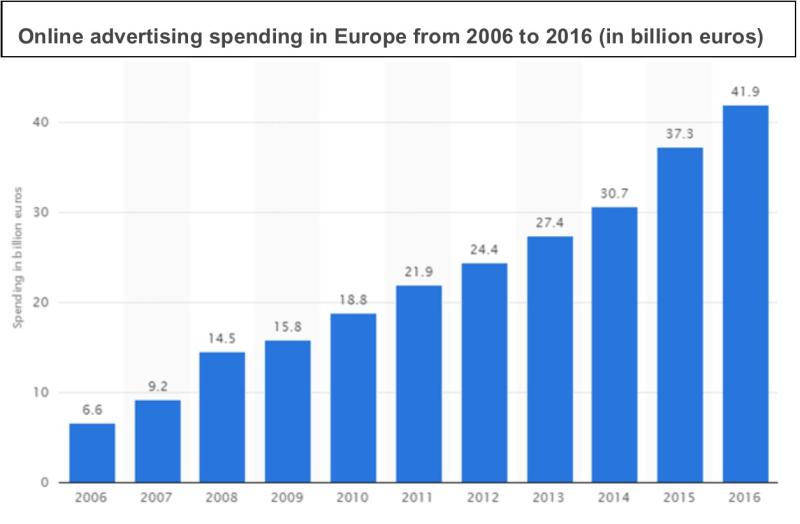Online Advertising
Our final instalment for the programme is brought to you by our Online Marketer and Online Media Specialist, Andre de Waard, who shares his valuable insights into the ever-changing online advertising world's future. Andre's advice is to make sure you always keep an eye on this evolving digital landscape: "The only thing that won’t change, is that everything will continue to change." -Andre de Waard

The first commercial banner appeared on the internet in 1994. It was shown on the website Wired (back then HotWired) on October 27th. It was an ad for AT&T. A lot has happened since that first banner. Online advertising nowadays is much more than banners (now often called display advertising). Online advertising has grown rapidly over the years.

Online advertising is almost as big as TV advertising (in spend) nowadays. Online advertising has become much more than just simple banners or display advertising. And here are some current trends for 2017 and beyond.
- Increased usage of adblockers – More and more people find online adverts intrusive and irritating. Therefore, it is expected that a third of all internet users will use an ad blocker on their (mobile) device in 2017.
Challenge: to find other, non-intrusive forms of online adverting to reach the consumer.
Mobile ads are exploding – While the growth on desktop is flat, mobile ad revenue is exploding. According to the IAB the first half of 2016 internet adverting revenue reached $ 32.7 billion. Mobile grew 89% and represents 47% of the total internet advertising revenue. Between Q2 2015 en Q2 2016 desktop fell 13%. Because more and more consumers consume information from their smartphone also the ad spend on mobile is expected to grow the coming years.
Challenge: make sure your website is optimized for mobile (mobile first) and make use of mobile advertising, that is where the target audience is.
- Google and Facebook reign the internet – The 2016 Mary Meeker’s Kleiner Perkins Internet Trends report show that 76% of growth in digital advertising went to Facebook and Google. It is expected that by 2018 Facebook and Google will account for 61% of the total digital ad revenue.
Challenge: it is almost impossible not to advertise using these parties. Because the target group is using Facebook and Google. So advertisers are almost ‘forced’ to advertise here.
- Programmatic advertising – this is the use of automated systems and data to buy media without human interference. How does it work?
- Advertisers bid for advertising space.
- Advertisers set variables based on the price and markets they are targeting.
- While a web page with an ad space is being loaded, the information that’s been gathered about the visitor is sent back and forth to an ad exchange.
- The advertising space gets auctioned off to the highest bidder and the ad space is placed in the space. This all takes place within a fraction of a second.
Programmatic advertising is not only reserved for online advertising but in the (nearby) future it will also be used for buying outdoor advertising, radio and television.
Challenge: make sure you know exactly who you are targeting on and make sure to use an expert agency for this type of media buying.
- Invasion of the chatbot – WhatsApp, WeChat and Facebook Messenger are three of the leading messaging platforms today that outpacing even some of the biggest social networks in terms of monthly active users. At the moment, there are about 18,000 bots that have been developed to help brands offer streamline, individualized service through chat. Facebook have already loosened their restrictions on sending promotional content via chatbot.
Challenge: think about how advertisers can fit chatbots into their marketing strategy. This can mean advertising with chatbots or creating a chatbot for your own company to get in touch with the consumer.
- Competition for search engines – research from Bloomreach showed that in 2016 most consumers started their search for products not via Google but via sites like Amazon. Instead of competition from Bing, Google gets (unexpected?) competition from other platforms.
- Artificial intelligence – all big, new digital initiatives are being realised (directly or indirectly) through AI. Last year Wired published an article with the significant title ‘Soon we won’t program computers. We’ll train them like dogs.’ (www.wired.com/2016/05/the-end-of-code/).
- Voice search continues to grow – Google says voice search is now 20% of all mobile searches. 55% of all teenagers are searching for something daily using their voice.
Two years ago smartphones were capable of recognizing 80% of spoken words. Nowadays this is about 92%. So, it is becoming more and more user friendly and accurate. Google wants to enter a new phase with the ambition to create the ultimate mobile assistant which helps you with everything in your daily life. The growth of voice search will not only come from the use of mobile internet, but also from devices like Google Home and Amazon Echo.
Google Home:
Echo:
Challenge: we talk differently to how we write. Therefore, it is important to optimize website content to spoken text.
- Video advertising will continue to grow – advertising budgets shift from offline to online, and Facebook and Google (YouTube) are competing strongly to get the attention of the viewer.
Challenge: realise that video advertising can not only be used as a branding tool but also to stimulate sales in combination with other marketing activities.
- Live video - social media users are beginning to demand more in-the-moment content, giving them a vicarious view into a world (or event) they’d previously been unable to access. Thanks to faster Internet and mobile devices, live video has become something of a trend on its own, with more and more apps and platforms giving some kind of “live streaming” functionality. Live video has been on an upward streak for the last few years, but it is believed that 2017 will be the year when it fully takes off, utilized by more brands and more individuals than ever.
- How about Snapchat - Snapchat is one of the most popular social apps today, but how? What exactly is so special about it, and why has it been quickly sweeping up mobile users faster than anything else? To make a long story short, Snapchat is an app that truly changed how people interact with friends compared to other popular social networks like Facebook and Twitter. Not everyone gets it — particularly older adults — but Snapchat sure is all the rage among the youngest smartphone users, including teens and young adults.
Native advertising will reach its peak - Native advertisements (advertisements that are part of the content and thus less disruptive to internet surfers) will continue to grow and become more significant in the larger sites. Brands have used it for years in search of an easy way to achieve natural visibility. But native advertising swings upward: while consumers continue to denounce or oppose most conventional forms of advertising, native advertising has become an elusive, yet effective, way of getting their attention. More and more big brands or content sites that have previously refused to offer native advertising offer it today in a number of ways.
The only thing that won’t change, is that everything will continue to change.
Challenge: to see these changes not as a threat, but as opportunities.
